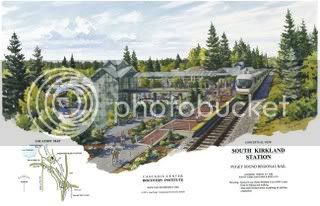Blog Eastside Commuter Rail An Affordable Regional Asset
Under a planned deal between the Burlington Northern Sante Fe railroad, the Port of Seattle and King County, a key 31-mile stretch of the Eastside BNSF rail line could be ripped out for scrap, and soon, to make way for a recreational trail. A recreational trail is a great asset, bring it on! But road congestion is a growing problem in Central Puget Sound; population is projected by regional planners to swell 52 percent by 2040; and current transit options are limited. The full Eastside rail corridor should be not only preserved, but utilized for commuter rail and a trail. The Seattle Times reports today on Cascadia Center’s proposal for an Eastside commuter rail line on the existing, 42-mile BNSF tracks from Renton to Snohomish, and a report we released last week from former BNSF executive Read Fay highlighting its feasibility.
Fay, who worked for BNSF for 35 years, rising to the post of Northwest operations chief, gave a presentation Monday night during a Cascadia-sponsored forum at Columbia Winery in Woodinville. Along with providing an overview of his report for us, he described existing machinery that can take up old track, and replace the wood ties with new concrete ones which will last 60 years. The cost is $800,000 per mile and it lays new track at a mile a day! What a relief for suffering Puget Sound commuters who wait for years for simple highway expansions.
Fay walked the entire line (Seattle Times graphic here) and estimated that track, tie and bridge work needed to permit 40 mph commuter line service would cost $37 million.  Our estimate for getting the line fully operational, including state-of-the-art, bio-diesel burning, bike-toting Deisel Multiple Unit train cars, is about $125 million. The cost for creating a similar system on 32 miles of track in Austin, Texas is $92 million. DMU commuter rail has been operational for six years in the West Palm Beach region and is coming on line between Oceanside and Escondido, California; in Washington County, Oregon; in Alaska; and on Amtrak’s Vermonter line.
Our estimate for getting the line fully operational, including state-of-the-art, bio-diesel burning, bike-toting Deisel Multiple Unit train cars, is about $125 million. The cost for creating a similar system on 32 miles of track in Austin, Texas is $92 million. DMU commuter rail has been operational for six years in the West Palm Beach region and is coming on line between Oceanside and Escondido, California; in Washington County, Oregon; in Alaska; and on Amtrak’s Vermonter line.
One question is who will pay for an Eastside rail line. A possibility, though not the only one, is that Sound Transit, which already operates commuter rail on other lines in the region, could step in. From the Seattle Times story today:
If Sound Transit decided to pay for diesel service, (King County Executive Ron Sims’ Chief of Staff Kurt) Triplett said, “we would be delighted with that. We would have them do that tomorrow. It’s not that King County is not trying to have a transportation system on the corridor. We want one. It’s that no one is coming with money on the table.”
Here’s an idea worth considering, one Cascadia and North Sound allies are already discussing in connection with an envisioned Everett to Bellingham DMU commuter rail line: a community rail partnership involving transit agencies and developers. Up north, that could involve (Snohomish County’s) Community Transit, Sound Transit (which runs “Sounder” commuter rail from Seattle to Everett already), plus transit agencies in Skagit, Island and Whatcom counties, and private developers who help pay for station improvements in return for enhanced local economic benefits.
For an Eastside community rail partnership, Sound Transit and Community Transit could be joined by (King County) Metro, plus private developers who pay for station improvements through Local Improvement Districts such as the one formed along the new South Lake Union street car line in Seattle. (A preliminary conceptual sketch of the Eastside line’s South Kirkland station, by J. Craig Thorpe for Cascadia Center, is above, right).
The flexibility of DMUs enhances their potential economic impact in Eastside communities. DMU coaches can travel not only on conventional rail, but also on track embedded in concrete, accessing downtown areas adjacent to the line, like Bellevue’s.
Another way to help pay for developing DMU commuter train service on the BNSF line is through tolling on the parallel highway, I-405. The Washington Department of Transportation is already implementing a new approach to tolling just south of I-405 on another north-south artery, State Route 167, with a High Occupancy and Toll (HOT) lane for carpoolers and solo drivers who will pay a premium for access, via electronic transponder tolls. That’s a good start, but there’s more needed. The new general purpose lanes being added to I-405 in each direction should instead become HOT lanes, and each of those twinned with the one existing carpool (HOV) lane in each directuion, which would also be converted to HOT lanes. Dual HOT lanes in each direction should be added to SR 167 for continuity, and – here’s the kicker – a portion of the I-405 tolls used to help fund the Eastside commuter rail line parallel to I-405. Another small portion of the tolls could help finance the planned recreational trail, for which current funding prospects are actually far less than assured.
We need to think big, but act practical. Voters firmly rejected the roads and transit ballot measure, Proposition 1, earlier this month, including an extension of Sound Transit’s light rail system east from Seattle across Lake Washington into Bellevue and north to Redmond. Given the election outcome, it seems smart to shift away from tax increases to pay for tens of billions of dollars worth of new light rail before the first leg (UW to Sea-Tac airport) is completed and operational. We should find a way instead to upgrade the existing BNSF track and run DMUs every 30 minutes at 40 mph between Renton and Snohomish, for a cost in the very low hundreds of millions.
Related:
“Transportation Action Plan for Puget Sound,” Cascadia Center;
“Eastside BNSF Rail Line Inspection Report,” Read Fay, for Cascadia Center;
“Cascadia: Eastside Corridor Can Support Interurban Rail,” KUOW-FM;
KOMO 1000 story;
“Preserve Eastside Rail Line for Snohomiish Transit Link,” Bruce Agnew, Seattle Times;
“Rails And Trails Could Co-Exist Easily On Eastside,” Bruce Agnew, Puget Sound Business Journal.
TECHNORATI TAGS: <a href="http://technorati.com/tag/BNSF, SEATTLE, PUGET SOUND, COMMUTER RAIL, EASTSIDE COMMUTER RAIL, CASCADIA CENTER, I-405, TOLLS, TOLLING"rel="tag"BNSF, SEATTLE, PUGET SOUND, COMMUTER RAIL, EASTSIDE COMMUTER RAIL, CASCADIA CENTER, I-405, TOLLS, TOLLING

